Bike Chain Size Guide And Chart
There is no universal bike chain that would fit all types of bikes. Bike chain sizes vary based on several factors. In my previous article, I already discussed the types of standard bike chains. Anyhow, I thought that we needed a separate article on bicycle chain sizes.
If you are replacing your bike chain by yourself, you need to be aware of the differences between bicycle chains.
In this article, we will be discussing different lengths and widths of bike chains. We’ll also discover an equation for determining the proper length of a standard bike chain, review a chart of bike chain sizes, and finally, we’ll answer some of the burning questions.
So, let’s start with the bicycle chain size chart and size guide.
Bike Chain Size Variables
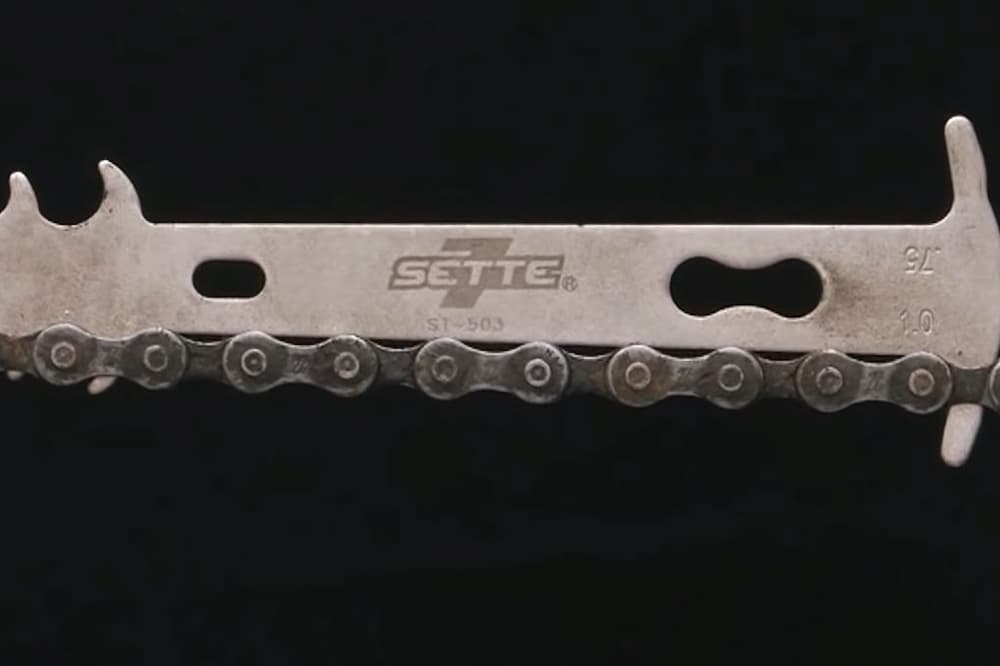
| Parameter | Description |
| Pitch | Distance between pin centers. Standard pitch for bicycle chains is 1/2 inch (12.7 mm). |
| Roller width | Width of the roller between the inner plates. Standard roller widths for bicycle chains are: 1/8 inch (3.175 mm), 3/32 inch (2.38 mm), and 11/128 inch (2.18 mm). |
| Chain width | Width of the chain measured across the rivet between chains. Standard chain widths for bicycle chains are: 5.3 mm for 12-speed chains, 5.5 mm for 11-speed chains, 6 mm for 10-speed chains, 6.5 to 7 mm for 9-speed chains, and 7 mm for 6, 7, and 8-speed chains. |
| Number of links | Number of links in the chain. This determines the length of the chain. |
| Chain weight | Weight of the chain. This varies depending on the materials used and the number of links. |
| Chain wear | The amount of wear that the chain has experienced. This can be measured by the amount of stretch in the chain. |
| Chain compatibility | The compatibility of the chain with different components, such as the cassette and chainrings. |
Link Lenght (Pitch)
The bike chain link pitch (distance between pin centers) is standardized and equals 1/2 inch or 12.7 millimeters. Historically there were also other pitch sizes, but the 0.5-inch pitch is standard these days.
Length (Total Length)
The total length of the bike chain is calculated by multiplying the number of links with a 1/2 inch link pitch.
I have seen chains with 100 up to 126 links.
I analyzed a list of best-selling bike chains on Amazon and found out that the most popular chain length is 116 links.
| # of Links | Models Available |
| 100 | 1 |
| 104 | 1 |
| 112 | 2 |
| 114 | 8 |
| 116 | 20 |
| 118 | 1 |
| 122 | 1 |
| 126 | 6 |
You can always shorten your bike’s chain. But it is not easy to increase the length of a bike chain. So, try to find an adequate size.
Internal Width
There are 4 sizes of the internal width of the bike chain – 1/8″, 3/32″, 11/128″, and 5/32″:
- 1/8″ (3.18 mm) – some of the bikes with a single rear sprocket
- 3/32″ (2.38 mm) – some of the bikes with a single rear sprocket, bikes with 5-8 rear sprockets, and derailleurs
- 11/128″ (2.18 mm) – bikes with 9-12 rear sprockets and derailleurs
- 5/32″ (4.0 mm) – freight bicycles and tricycles.
A simplistic way how to estimate your bike chain size:
- If you have a heavy-duty cargo bike or tricycle, you need a 5/32″ chain.
- If your bike is equipped with the derailleur, you need a 3/32″ or 11/128″ chain.
- If you have a single-speed or internally geared bike, you need either 1/8″ or 3/32″. You should get the correct size, but if it is impossible, you can use the 1/8″ chain because it has limited compatibility with the 3/32″ sprocket.
External Width
When you are shopping for a new chain for your multi-speed derailleur bike, the external width is another factor you should keep in mind. The proper width is determined by the number of rear sprockets your bike has – the more rear sprockets are spaced close together, the narrower chain should be used.
The external width of the chain is not something you should worry about in the case of a single-speed or single rear cog bike.
Bike Chain Size Chart
More often, cyclists like me end up with a lot of options in hand. We even turn confused about what to choose. So, for helping in properly selecting bike chains, I am sharing a bike chain size chart below.
While single-speed bike chains have different measurements, the size chart below is applicable for most geared bikes. The chart combined with this guide and equation should be adequate for determining the bike chain’s size.
| Drivetrain* | External Width, in | External Width, mm | Internal Width, in |
| 5 / 6 / 7 / 8 speed | 9/32″ | 7.1 – 7.3 mm | 3/32″ |
| 9 speed | 1/4″ – 9/32″ | 6.5 – 7.0 mm | 11/128″ |
| 10 speed | 1/4″ – 9/32″ | 6.0 – 7.0 mm | 11/128″ |
| 10 speed narrow | 7/32″ | 5.88 mm | 11/128″ |
| 11 speed | 7/32″ | 5.5 – 5.62 mm | 11/128″ |
| 12 speed | 13/64″ | 5.3 mm | 11/128″ |
* Number of rear sprockets
Tips:
- there is some variance between chainsets from different manufacturers, so it is advised to get a chain from the manufacturer of your bike’s chainset
- you can use a narrower chain than your bike specs call for, but remember that thinner chains are more expensive and less sturdy
- if you use a narrow chain with a worn-out chainset, the chain can fall between the sprockets
How To Find The Proper Length Of the Chain?
Use The Old Chain
If your old chain still holds a great shape with proper length, you can use it for comprising when buying your new chain.
Just lay the new chain besides the original chain. Outer plates should be aligned with outer plates and inner ones with inner plates. You can use the master link to get a proper comparison.
If you have used the chain for a prolonged period, the chain will most likely be subject to the chain stretch, so this method could not provide the correct data.
Largest Cog and Largest Chainring Method
On the contrary, if you don’t have your old chain, you can also use the largest cog and largest chainring method to measure your bike’s chain size.
The process is as follows:
- Change the front derailleur on the biggest chainring and the back derailleur on the smallest cog.
- Start by covering the biggest back cog with the chain.
- If you have one end of the new chain on the outer plate, you should route it towards the front chain.
- Take the chain and pass it through the front derailleur cog and keep it put in the 5 o’clock position.
- If you have a master link, install half master link.
- Take the lower section and bring it close to the previously held front chainring.
- Pay proper attention and detect the reference rivet where your chain’s both end matches with maximum tension.
- Add one rivet with the reference rivet, and the newest one becomes their reference rivet. You’ll need this as you won’t be able to join on the earlier reference rivet.
- Cut the chain on the additional rivet to the new reference rivet by using a chain tool.
There are a few exceptions. You need to add four rivets with the reference rivet in SRAM derailleur with 11 or 12-speed cassettes.
Besides, you also need to consider the rear suspension. As your bike pushes the rear suspension, the distance between chainring and cogs will decrease. For proper setting, disconnect your bike’s rear suspension shock and set up the linkage.
Finding Chain Length From Equation
Bicycle chain lengths are whole integers. They cannot be fractions as they consist of outer and inner plates.
We can find the length of the bike’s chain using an industrial equation for derailleur chains.
For measuring the length of bicycle chain size, you need to do the following:
- Count the number of teeth on the biggest front sprocket and largest rear sprocket. You can find the numbers printed on the sprockets too.
- Next, you need to measure the distance between the crank bolt’s rear axle and midpoint.
- Measure the distance to the nearest 1/8 inches and convert it into decimals.
- Then, you use the equation for finding the length of your chain.
Here is a simple equation of bike’s length:
L = 2 (C) + (F/4 + R/4 + 1)
Here,
L= Length of the chain in inches.
C= Chainstay length in inches from the above-described steps.
F= Number of Teeth on the biggest front sprocket.
R= Number of Teeth on the biggest rear sprocket.
When you determine the length, it may contain fractions. Just round it off to the nearest whole integer.
Anyhow, this equation is not applicable for bikes with extreme variation in chainring sizes or short chainstays. In such cases, you need to use a complex and rigorous equation which is:
Chain length, L = 1 + 0.25 X (F+R) + 2 X
Frequently Asked Questions
How do I know my bike chain size?
You can know the size of your bike chain size from the above bike size chart. You can also manually detect the size by using the equation for the bike chain size stated above.
What is the standard bike chain size?
Standard bike chain size stands for the regularly acceptable bike chain standard dimension. It mainly includes the sizing of inner and outer width along with size charts.
For example, single-speed chains have standard 1/8 inches width, while multi-speed chains with 5-8 speeds have an inner width of 3/32 inches. Bikes with 9-12 speeds have 11/128 inches inner width. The outer width also varies based on speeds. We have documented a standard bike chain size chart above.
What size chain should I get?
You should get the chain size that aligns with your bike. There are equations and charts for determining the size. Read the whole article for details.
Are all bicycle chains the same size?
No, all bicycle chains are not the same size. Size varies on the bike’s numbers of sprockets, speeds, the distance between the front chainring and rear cogs, and the number of teeth on them.
What are the different chain sizes?
Chains sizes are different from each other based on the type of bicycle. Besides, they are also variable when considering the interior structure and design of similar types of vehicles. Mainly, bicycle chains come in 3/32 inches, 1/8 inches, 5/32 inches, 3/16 inches roller widths.
How do you size a 1×11 chain?
You can size a 1×11 chain by following several steps. These steps are listed below:
- Change the back derailleur on the smallest cog.
- Start by covering the biggest back cog with the chain.
- If you have one end of the new chain on the outer plate, you should route it towards the front chain.
- Take the chain and pass it through the front derailleur sprocket and keep it put in the 5 o’clock position.
- If you have a master link in the chain, install half master link.
- Take the lower section and bring it close to the previously held front chainring.
- Pay proper attention and detect the reference rivet where your chain’s both end matches with maximum tension.
- Add four rivets with the reference rivet, and that will be your new cutting point.
- Cut the chain on the cutting point by using a chain tool.
Are 6, 7, 8-speed chains the same?
No, they are not the same. You can use a 7.1 mm wide 8-speed chain on all of them, but the Chain for 6 and 7 speeds is wider than 8. So, you can use an 8-speed chain on 6 and 7. But you shouldn’t use 6-speed chains on 7 and 8 or 7-speed chains on 8.
Do bike chains have directions?
Yes, some of the bike chains have directions. You can detect the direction by determining any printed letters or logos on the chain. The outer side of the text should be on the drive side.
What is the difference between 10 and 11-speed chains?
The significant difference between the 10 and 11-speed chains is the external chain width. Though they both have almost similar width and cassette teeth, 11 speed’s chain width is 5.62 mm while the 10-speed chain’s width is 5.88 mm. Are they interchangeable? Yes and no. You can use 11-speed chains on 10-speed bikes (and pay the premium price because the narrow chains tend to be more expensive). But a 10-speed chain will likely be too wide for the 11-speed gear set.
Can you use the regular bicycle chain on the motorized bike?
Yes, you can use the regular bicycle chain on the motorized bike’s pedal drive. A motorized bike also uses a second chain as a drive. The size #415 drive chain, e.g., King PRO COMPANY bike chain, is thicker and heavier and is explicitly designed for motorized bikes. Coming with a durable and versatile design, it can be used in 2 stroke bikes.
Conclusion
It’s clear that choosing the right size bike chain is more than just numbers and measurements—it’s about ensuring that our bikes operate at their peak efficiency and reliability. Throughout this guide, I’ve navigated the labyrinth of bike chain sizes, exploring variables like pitch, roller width, and chain compatibility. Armed with charts and equations, we’ve unlocked the mysteries behind choosing the perfect chain for our beloved two-wheelers.
Choosing the right chain is a journey filled with precision and care, reflecting our dedication as cyclists. It’s not merely about finding a chain that fits; it’s about discovering a component that resonates with our biking style and the unique characteristics of our bicycles. In my experience, the right chain acts as the unsung hero of our biking adventures, driving us forward with reliability and strength.
In the realm of bike chains, knowledge is indeed power. Understanding the nuances, like the significance of internal and external widths and the importance of compatibility, empowers us to make informed decisions, enhancing our overall cycling experience. So, as we pedal into the future, let’s carry the insights from this Bike Chain Size Guide with us, fostering a cycling experience marked by performance and joy.

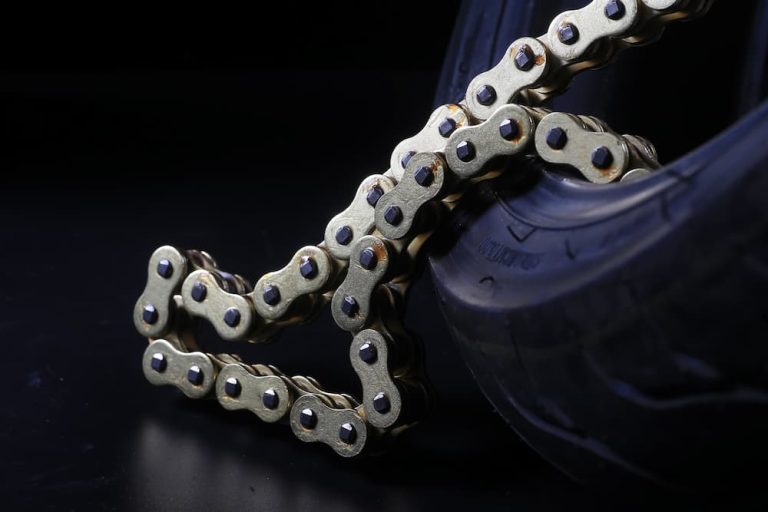
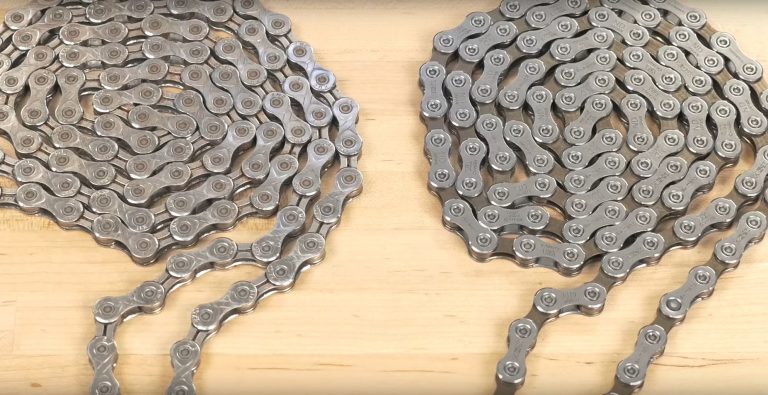
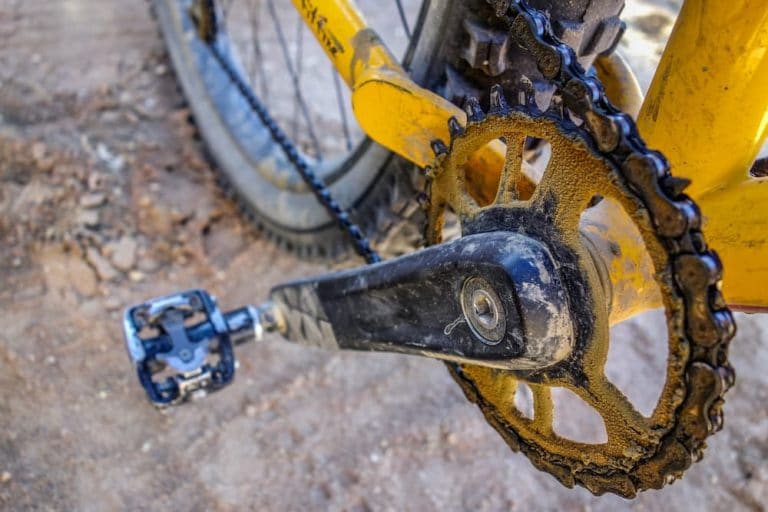
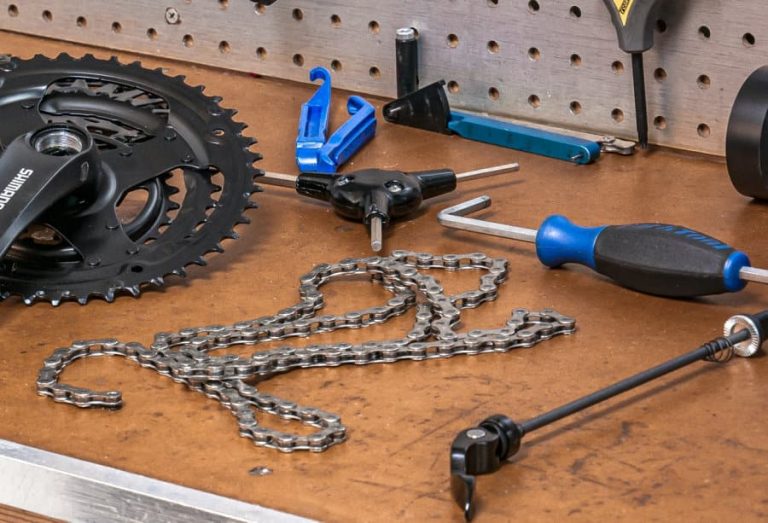
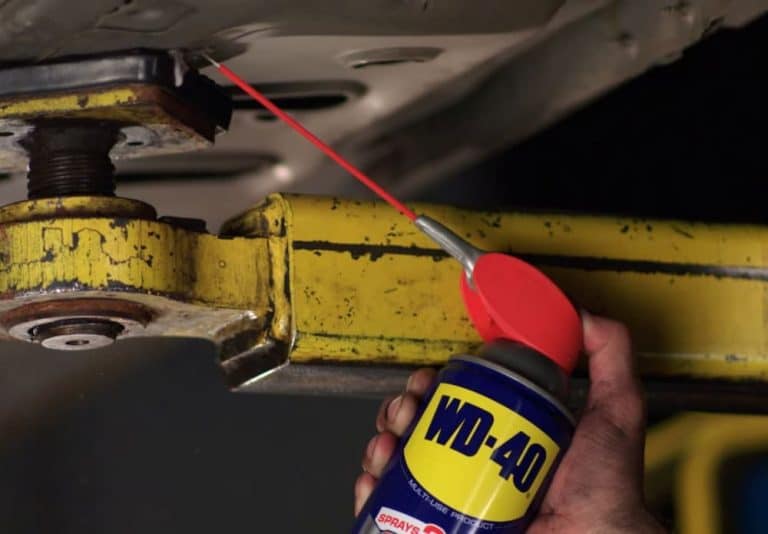

Thanks for the excellent article. Probably the best on this topic.
I’ve just put an mtb triple crankset on mt road bike (all Shimano). I’m only using the inner 2 chainrings (28/42) as I live on a mountain Everything lined up perfectly, including zero adjustment on the front derailleur. However, the 10 speed chain is sometimes falling between the chainrings. The crankset is sold as “9x/10x” (about 7.8mm c-c between rings and 5.8mm gap between the “plates” of the chainrings. In your article you mention narrow chains falling between wide-set cassettes. In my case, a difference of just 1 speed is a problem on the crankset. I thought that your readers might want to watch out for this issue. I’m hoping it’s easily solved by using a “chunk” 9 speed mtb chain (around 6.6mm width) – wide enough to stay out of the approx 6.2-6.5mm gap between the tips of the teeth.
Thank you for sharing your experience, Brett!
Your Bike Chain Size Chart above has multiple errors, including incorrect inch to mm conversion please check it out.
I appreciate your chiming in. I checked the conversions, and they look fine. Can you point me in the right direction?